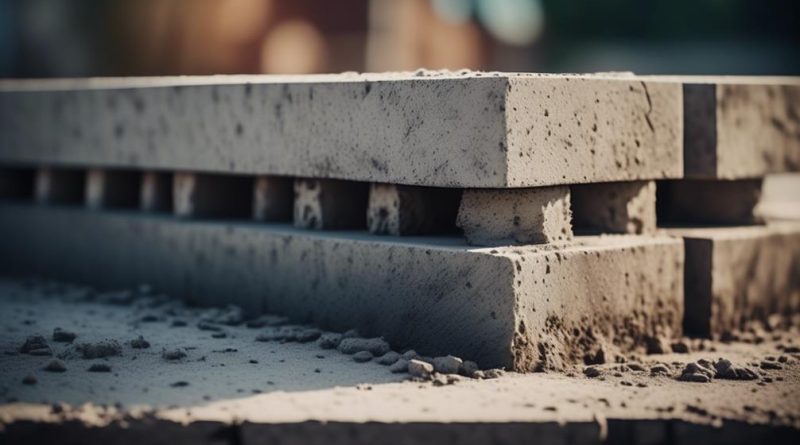Exploring Diverse Home Foundation Options
Choosing the right foundation for your home is a crucial decision that requires careful consideration. With a wide range of options available, from basements to crawl spaces, slabs to pier and beam, and even insulated concrete forms, it's important to explore the diverse home foundation options before making a final choice.
Each option has its own strengths and weaknesses, and factors such as climate, budget, and soil conditions should all be taken into account. In this article, we will uncover the pros and cons of each foundation type, providing you with the essential information needed to make an informed decision for your next construction project.
So, let's dive in and discover the world of diverse home foundation options.
Key Takeaways
- Basement foundations provide extra living space but can be expensive to build and maintain, with the potential for water intrusion or flooding.
- Crawl space foundations are more affordable than basements and provide access for maintenance, but may have moisture and pest issues.
- Slab foundations are quick and low-cost to construct, but not suitable for cold climates and can be difficult to repair embedded mechanical systems.
- Poured concrete foundations are versatile and durable, suitable for various climate zones, but require excavation and solid footing, and may need reinforcement with rebar.
Basement Foundations
Basement foundations are a type of home foundation that consist of a concrete base and tall walls, providing additional living space, primarily common in colder climates. They offer several advantages, such as creating extra usable square footage for storage, recreational areas, or additional living space.
However, basement foundations also present challenges, including the potential for water intrusion or flooding. Common issues with crawl space foundations include moisture problems, such as excessive humidity or standing water, which can lead to mold growth and structural damage. Additionally, crawl spaces can be prone to pest infestations and require regular maintenance to ensure proper ventilation and moisture control.
Despite these drawbacks, basement foundations remain a popular choice for homeowners seeking additional space and functionality in their homes.
Crawl Space Foundations
Crawl space foundations, characterized by shallow height poured concrete walls, offer a more affordable alternative to basement foundations while providing accessibility for maintenance of home systems.
- Benefits of crawl space foundations:
- Cost-effective option compared to basements
- Allows easy access to home systems for maintenance and repairs
- Provides additional storage space
- Common issues with crawl space foundations:
- Potential for moisture buildup leading to mold and mildew growth
- Susceptible to pest infestations, such as rodents and termites
- Requires proper insulation and ventilation to prevent energy loss and humidity buildup
Crawl space foundations are a practical choice for homeowners looking for a more budget-friendly foundation option while still maintaining accessibility for maintenance needs. However, it's important to address common issues such as moisture control and pest prevention to ensure the longevity and functionality of the crawl space foundation.
Slab Foundations

Slab foundations, characterized by a single concrete slab, are a commonly used and cost-effective option for building homes in warm climates. One of the main advantages of slab foundations is their quick and low-cost construction. They eliminate the need for extensive excavation and the building of walls or footings, making them an efficient choice.
Additionally, slab foundations offer a level surface that is ideal for easy accessibility and mobility within the home. However, there are some drawbacks to consider. Slab foundations can be challenging to repair if embedded mechanical systems such as plumbing or electrical lines become damaged. They also lack the insulation and protection from extreme weather that other types of foundations provide.
When comparing slab foundations to other options, it is important to consider the specific needs of the location and the potential pros and cons of each foundation type.
Poured Concrete Foundations
When considering different options for home foundations, one notable choice to explore is poured concrete foundations. This type of foundation is the most common and offers several advantages.
Advantages of poured concrete foundations:
- Versatility: Poured concrete foundations can be customized to fit various architectural designs and accommodate different building requirements.
- Durability: Concrete is a strong and long-lasting material, providing a solid and stable foundation for the home.
- Suitable for various climates: Poured concrete foundations can withstand extreme weather conditions, making them suitable for both cold and warm climates.
However, there are also some disadvantages to consider:
- Cost: Poured concrete foundations can be more expensive compared to other foundation options due to the excavation and solid footing required.
- Maintenance: Regular maintenance is necessary to prevent cracks and moisture issues in the concrete. This includes inspecting for any signs of damage and addressing them promptly.
To maintain poured concrete foundations, consider the following tips:
- Keep the foundation clean and free from debris to prevent moisture buildup.
- Seal any cracks or gaps in the foundation to prevent water intrusion.
- Regularly inspect the foundation for any signs of damage, such as cracks or uneven settling, and consult a professional if needed.
Pier and Beam Foundations

Pier and beam foundations provide a raised structure that offers protection against flood levels and is particularly suitable for sloped areas or coastal locations. These foundations consist of a series of vertical piers or columns that support horizontal beams, which in turn support the floor structure of the home.
One of the strengths of pier and beam foundations is their ability to withstand high-water levels, making them a wise choice for areas prone to flooding. Additionally, the raised design allows for better ventilation and easier access to utilities and plumbing systems.
However, there are some weaknesses to consider. Pier and beam foundations require regular inspections and repairs due to the potential for moisture damage and pest infestation. They also do not provide additional storage space like other foundation types.
When choosing a pier and beam foundation, factors to consider include the local climate, soil conditions, and the cost and maintenance requirements associated with this type of foundation.
Insulated Concrete Form (ICF) Foundations
Continuing the exploration of various foundation options, the focus now turns to Insulated Concrete Form (ICF) Foundations, a cutting-edge solution that offers exceptional durability, energy efficiency, and resistance to moisture and pests. Some advantages of ICF foundations include:
- Superior insulation properties, reducing energy consumption and lowering utility bills.
- Enhanced thermal comfort, maintaining a consistent indoor temperature throughout the year.
- Improved soundproofing, creating a quieter living environment.
- Increased structural strength and resistance to natural disasters, such as earthquakes and high winds.
- Reduced risk of mold, mildew, and pest infestations due to the absence of wood components.
- Long lifespan with minimal maintenance requirements.
However, there are also some disadvantages to consider:
- Higher initial cost compared to traditional foundation systems.
- Specialized construction techniques and skilled labor may be required.
- Limited design flexibility due to the fixed nature of the ICF forms.
Frequently Asked Questions
Are There Any Specific Building Codes or Regulations That Need to Be Followed When Constructing Each Type of Foundation?
Building code requirements and construction regulations vary by location and foundation type. It is essential to consult local authorities and professionals to ensure compliance with specific codes and regulations when constructing each type of foundation.
What Are the Typical Costs Associated With Each Type of Foundation, Including Installation, Maintenance, and Repairs?
The typical costs associated with each type of foundation, including installation, maintenance, and repairs, vary depending on factors such as the foundation material, climate, and location. A cost comparison can be done to weigh the pros and cons of each option.
How Long Does It Typically Take to Construct Each Type of Foundation?
The construction time for each foundation type varies depending on factors such as size, complexity, and weather conditions. It is recommended to consult with professionals to determine the specific construction time for each foundation type.
Are There Any Specific Soil Conditions or Site Requirements That Need to Be Considered for Each Type of Foundation?
Specific soil conditions and site requirements must be considered for each foundation type. Proper site preparation, including geotechnical analysis, is crucial to ensure stability and prevent issues such as settling, shifting, or water intrusion. Professional guidance is essential for optimal results.
What Are the Potential Risks or Common Issues That Homeowners May Face With Each Type of Foundation, and How Can They Be Mitigated or Addressed?
Common foundation problems vary depending on the type of foundation. For example, basements may experience water intrusion or flooding, while crawl spaces may face moisture and pest issues. Regular maintenance and inspections are essential to identify and address these issues promptly. Best practices for foundation maintenance include proper drainage, sealing cracks, and monitoring moisture levels. Consulting with professionals can provide guidance on specific mitigation strategies for each foundation type.
Conclusion
In conclusion, exploring the diverse options for home foundations is crucial in order to make an informed decision that aligns with specific needs and priorities.
Factors such as climate, budget, and soil conditions should be carefully considered. By understanding the strengths and weaknesses of each foundation type, homeowners can ensure the longevity and stability of their homes.
Regular maintenance and inspections are also essential.
Remember, choosing the right foundation is like laying a solid groundwork for a sturdy and resilient home.




